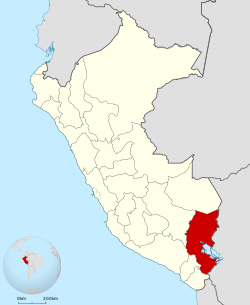Puno Region
| Puno Region | ||
|---|---|---|
| Region | ||

Lake Titicaca, which is partly located in the Puno Region
|
||
|
||
 Location of the Puno Region in Peru |
||
| Coordinates: 15°04′S 70°07′W / 15.07°S 70.12°WCoordinates: 15°04′S 70°07′W / 15.07°S 70.12°W | ||
| Country | Peru | |
| Subdivisions | 13 provinces and 108 districts | |
| Capital | Puno (138000) | |
| Government | ||
| • President | Mauricio Rodriguez (2011-2014) | |
| Area | ||
| • Total | 66,997 km2 (25,868 sq mi) | |
| Highest elevation | 4,725 m (15,502 ft) | |
| Lowest elevation | 820 m (2,690 ft) | |
| Population (INEI estimate 2011) | ||
| • Total | 1,364,362 | |
| • Density | 20/km2 (53/sq mi) | |
| UBIGEO | 21 | |
| Dialing code | 0+51 | |
| ISO 3166 code | PE-PUN | |
| Principal resources | Quinoa; it is also the nation's largest producer of potatoes, sheep, alpacas and llamas. | |
| Poverty rate | 60.8% (INEI 2009) | |
| Percentage of Peru's GDP | 2.3% | |
| Website | www.regionpuno.gob.pe | |
Puno is a region in southeastern Peru. It is bordered by Bolivia on the east, the Madre de Dios Region on the north, the Cusco and Arequipa regions on the west, the Moquegua Region on the southwest, and the Tacna Region on the south. Its capital is the city of Puno, which is located on Lake Titicaca in the geographical region known as the Altiplano or high sierra.
Puno was the territory of the Tiahuanacos (800 A.D. – 1200 A.D.), who were the highest cultural expression of the Aymara people who established themselves in what is today Peru and Bolivia. The Incas took over these lands in the fifteenth century, and the Spanish, attracted by the mining industry developed there, left an important Colonial legacy throughout the entire area.
The Puno region is located in the Collao Plateau. The western part of Lake Titicaca, which is the world's highest navigable lake, is located in the region. The Andean mountains make up 70% of the region's territory, and the rest is covered by the Amazon rainforest.
The lake contains numerous islands whose inhabitants continue to live as their ancestors have in custom and tradition. The Uros an example of this; this people group lives on "floating islands" that they have artificially made entirely of totora reeds, and they navigate in their traditional boats also made out of totora reeds. Taquile, Suasi, and Amantaní are known for their kindness of their residents, their ancestral skill in weaving, their pre-Columbian constructions, and lovely countryside. The Titicaca National Reserve (36,180 hectares) protects extensive stretches of totora reeds and various species of plants and animals.
The climate is cold and dry, with a four-month rain season. On the other hand, the climate of the rainforest is warm. The water resources are taken from the Lake Titicaca, 50 lagoons and more than 300 rivers. There is also an important potential in underground waters.
...
Wikipedia

